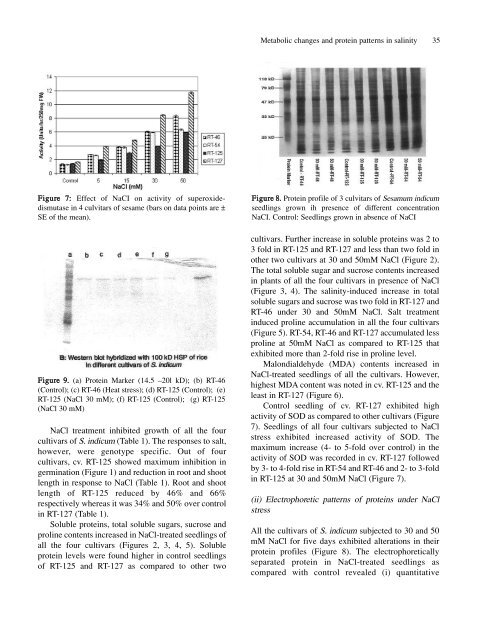Full Journal - Journal of Cell and Molecular Biology - Haliç Üniversitesi
Full Journal - Journal of Cell and Molecular Biology - Haliç Üniversitesi
Full Journal - Journal of Cell and Molecular Biology - Haliç Üniversitesi
You also want an ePaper? Increase the reach of your titles
YUMPU automatically turns print PDFs into web optimized ePapers that Google loves.
Figure 7: Effect <strong>of</strong> NaCI on activity <strong>of</strong> superoxidedismutase<br />
in 4 culvitars <strong>of</strong> sesame (bars on data points are ±<br />
SE <strong>of</strong> the mean).<br />
Figure 9. (a) Protein Marker (14.5 –20l kD); (b) RT-46<br />
(Control); (c) RT-46 (Heat stress); (d) RT-125 (Control); (e)<br />
RT-125 (NaCl 30 mM); (f) RT-125 (Control); (g) RT-125<br />
(NaCl 30 mM)<br />
NaCl treatment inhibited growth <strong>of</strong> all the four<br />
cultivars <strong>of</strong> S. indicum (Table 1). The responses to salt,<br />
however, were genotype specific. Out <strong>of</strong> four<br />
cultivars, cv. RT-125 showed maximum inhibition in<br />
germination (Figure 1) <strong>and</strong> reduction in root <strong>and</strong> shoot<br />
length in response to NaCl (Table 1). Root <strong>and</strong> shoot<br />
length <strong>of</strong> RT-125 reduced by 46% <strong>and</strong> 66%<br />
respectively whereas it was 34% <strong>and</strong> 50% over control<br />
in RT-127 (Table 1).<br />
Soluble proteins, total soluble sugars, sucrose <strong>and</strong><br />
proline contents increased in NaCl-treated seedlings <strong>of</strong><br />
all the four cultivars (Figures 2, 3, 4, 5). Soluble<br />
protein levels were found higher in control seedlings<br />
<strong>of</strong> RT-125 <strong>and</strong> RT-127 as compared to other two<br />
Metabolic changes <strong>and</strong> protein patterns in salinity 35<br />
Figure 8. Protein pr<strong>of</strong>ile <strong>of</strong> 3 culvitars <strong>of</strong> Sesamum indicum<br />
seedlings grown ih presence <strong>of</strong> different concentration<br />
NaCI. Control: Seedlings grown in absence <strong>of</strong> NaCI<br />
cultivars. Further increase in soluble proteins was 2 to<br />
3 fold in RT-125 <strong>and</strong> RT-127 <strong>and</strong> less than two fold in<br />
other two cultivars at 30 <strong>and</strong> 50mM NaCl (Figure 2).<br />
The total soluble sugar <strong>and</strong> sucrose contents increased<br />
in plants <strong>of</strong> all the four cultivars in presence <strong>of</strong> NaCl<br />
(Figure 3, 4). The salinity-induced increase in total<br />
soluble sugars <strong>and</strong> sucrose was two fold in RT-127 <strong>and</strong><br />
RT-46 under 30 <strong>and</strong> 50mM NaCl. Salt treatment<br />
induced proline accumulation in all the four cultivars<br />
(Figure 5). RT-54, RT-46 <strong>and</strong> RT-127 accumulated less<br />
proline at 50mM NaCl as compared to RT-125 that<br />
exhibited more than 2-fold rise in proline level.<br />
Malondialdehyde (MDA) contents increased in<br />
NaCl-treated seedlings <strong>of</strong> all the cultivars. However,<br />
highest MDA content was noted in cv. RT-125 <strong>and</strong> the<br />
least in RT-127 (Figure 6).<br />
Control seedling <strong>of</strong> cv. RT-127 exhibited high<br />
activity <strong>of</strong> SOD as compared to other cultivars (Figure<br />
7). Seedlings <strong>of</strong> all four cultivars subjected to NaCl<br />
stress exhibited increased activity <strong>of</strong> SOD. The<br />
maximum increase (4- to 5-fold over control) in the<br />
activity <strong>of</strong> SOD was recorded in cv. RT-127 followed<br />
by 3- to 4-fold rise in RT-54 <strong>and</strong> RT-46 <strong>and</strong> 2- to 3-fold<br />
in RT-125 at 30 <strong>and</strong> 50mM NaCl (Figure 7).<br />
(ii) Electrophoretic patterns <strong>of</strong> proteins under NaCl<br />
stress<br />
All the cultivars <strong>of</strong> S. indicum subjected to 30 <strong>and</strong> 50<br />
mM NaCl for five days exhibited alterations in their<br />
protein pr<strong>of</strong>iles (Figure 8). The electrophoretically<br />
separated protein in NaCl-treated seedlings as<br />
compared with control revealed (i) quantitative

















